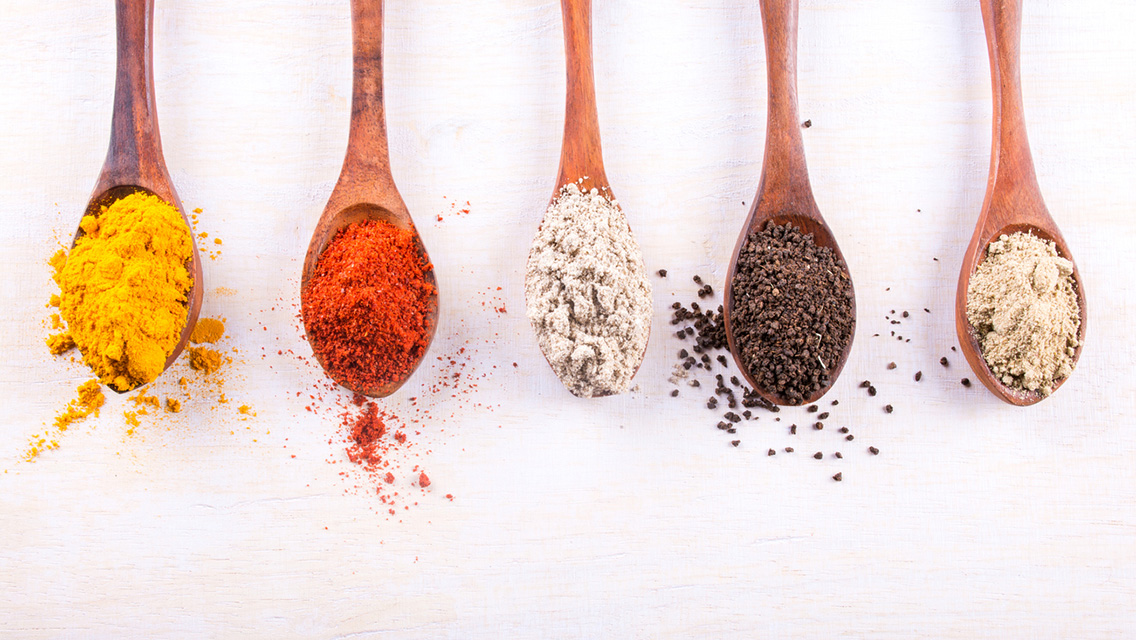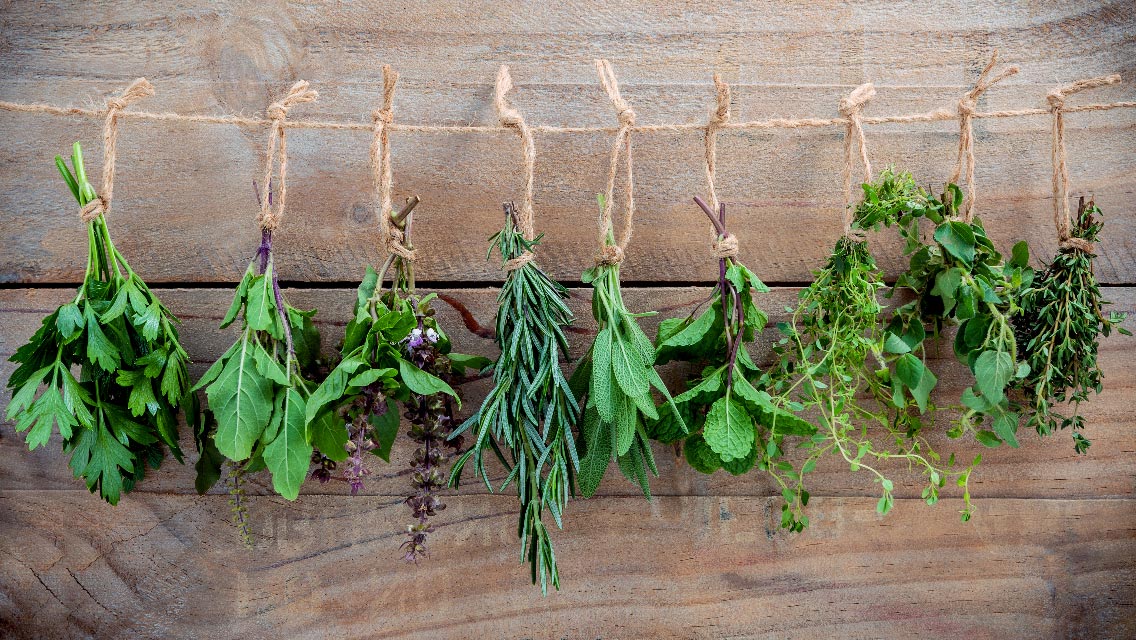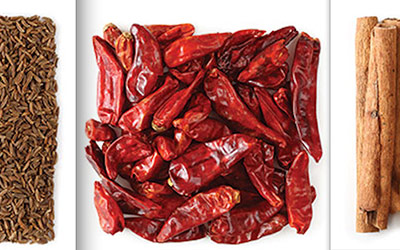Learn more about these healing spices and simple ways to incorporate more into your diet:
Cinnamon ⋅ Turmeric ⋅ Coriander ⋅ Fennel Seed ⋅ Ginger
When I was growing up in India, spices were not just a part of every meal, they were the main medicines my family used for everyday healing. My mother cooked with brilliant yellow turmeric powder daily, but she’d also sprinkle it on a cut when I hurt myself. Or put it on my forehead when I had a fever. If I was nauseated, my mother gave me ginger to make me feel better. If I couldn’t sleep, she gave me coriander in warm milk. On sweltering summer days, she made our family a refreshing drink out of kokum, an Indian spice that would cool us off as instantly as if we were all standing under a waterfall. It seemed like almost every spice in our giant spice cabinet was a food and a medicine.
Now, as a professor in the Department of Experimental Therapeutics at the University of Texas MD Anderson Cancer Center, spices are the subject of many experiments in my laboratory.
It was at this lab, almost 20 years ago, that I discovered that curcumin, the active ingredient in turmeric, is effective against cancer. Today, my colleagues and I are working to discover the molecular and biochemical secrets behind the therapeutic power of so many other healing spices. We are striving to harness that power in the battle against cancer and other chronic diseases.
Back in 1995, when I started investigating turmeric, there were fewer than 50 published scientific studies on the healing potential of spices. Today, there are thousands. Worldwide, researchers have discovered that spices contain compounds that fight oxidation and inflammation, the two processes underlying most chronic disease. Countless studies have linked culinary spices to the prevention and treatment of more than 150 health problems. These studies have not escaped the attention of the FDA and the NIH — but our government is not acting fast enough to inform the public that the typical American diet is sorely lacking in spices. To me, it seems astonishing that spices are not even mentioned in the USDA’s food guidelines!
Many people talk about including whole foods — such as vegetables, legumes and fruits — in one’s diet, but the real secret to preventing disease and prolonging life is a diet rich in whole foods and spices.
To get you started, here are five easy-to-find spices I hope you’ll begin cooking with more often, starting today. May they and other spices become a friend to your health — and the pride of your kitchen!
Cinnamon
Health Benefits: Balances Blood Sugar
Maybe it’s ironic that cinnamon — that spicy-sweet favorite that cooks use to give desserts extra flavor — can help control blood-sugar problems. Or maybe — given the fact that the rate of type 2 diabetes in the United States has doubled in the past two decades — it’s Mother Nature’s way of cutting us a break.
Study after study has shown that cinnamon can play a role in the everyday management of blood sugar (glucose) levels and other cardiovascular disease (CVD) risk factors.
Diabetes, a disease of chronically high blood sugar, attacks arteries and veins, increasing the risk of heart disease sixfold. The good news is that preventing type 2 diabetes and reversing prediabetes is possible with lifestyle changes alone — they are actually more effective than preventive medications.
In a recent U.S. study, published in the Journal of the American Board of Family Medicine, 109 people with type 2 diabetes were divided into two groups, with one receiving 1 gram of cinnamon a day and one receiving a placebo. After three months, those taking the cinnamon had a 0.83 percent decrease in their A1C, a measure of blood sugar. (Seven percent or less means the diabetes is controlled, and a decrease between 0.5 and 1.0 percent is considered a significant improvement.) Those taking the placebo had only a 0.37 percent decrease in A1C blood-sugar levels.
Cinnamon helps control blood-sugar levels in the short term as well. Swedish researchers studied 14 people, feeding them the same meal twice — rice pudding, with or without a hefty sprinkling of cinnamon. The cinnamon-spiced meal yielded significantly lower blood-sugar levels.
Richard Anderson, PhD, a scientist at the Beltsville Human Nutrition Research Center of the U.S. Department of Agriculture, who has conducted several studies on cinnamon and diabetes, theorizes that the spice mimics the action of insulin, the hormone that regulates blood sugar. It may stimulate insulin receptors on fat and muscle cells the same way insulin does, he says, allowing excess sugar to move out of the blood and into the cells.
May also help prevent and treat:
Cancer, cholesterol problems, food poisoning, heart disease, hypertension, insulin resistance, polycystic ovarian syndrome, stroke, ulcer, vaginal yeast infection, wounds.
How to buy cinnamon:
Ground cinnamon begins to fade in flavor after a few months, so it’s best to buy whole cinnamon quills (or sticks) and grind as needed. The quills are somewhat tough, so you’ll need a sturdy spice grinder or fine grater.
If your only option is to buy ground cinnamon, try to find good stuff made from whole quills, as opposed to “featherings” (which are the inner bark of twigs and small shoots that are not large enough to form a full quill) or from “cinnamon chips” (made from shavings and trimmings). When in doubt, buy Ceylon cinnamon, which comes from Sri Lanka and is widely considered to be the best in the world. (See “How to Choose the Best Cinnamon” for more.)
Cooking tips:
- Simmer a whole cinnamon quill in soups or stews.
- Sprinkle cinnamon on apples, bananas, melons, and oranges.
- Combine equal parts cinnamon, cardamom and black pepper, and use as a rub for meats.
- Mix cinnamon into rice pilaf.
- Make spiced tea: Put a quart of brewed tea into a pot, add 2 cups of apple juice, and gently simmer with a sliced lemon and two cinnamon sticks for 10 minutes.
Turmeric
Health Benefits: Reduces Inflammation
Turmeric is a kitchen staple in India, found in just about every dish that crosses the table — a fact that has not been lost on researchers, who observed 30 years ago that the incidence of chronic illnesses among people in India is significantly lower than in most Western countries, especially the United States.
Turmeric owes its preventive and curative characteristics to its active ingredient curcumin, a compound so diverse and powerfully rich in antioxidant and anti-inflammatory actions that thousands of studies have shown that it protects and improves the health of virtually every organ in the body. Turmeric’s powerful properties help prevent oxidation and the resulting chronic, low-grade inflammation that has been shown to trigger or advance many of the diseases of modern life.
In fact, wide research shows that turmeric, taken as supplemental curcumin, is as effective and, in some cases, even more effective than pharmaceutical drugs — without their side effects. Recently, my colleagues and I compared curcumin with anti-inflammatory and pain-killing medications. And we compared curcumin with cancer drugs, testing those agents for their effectiveness in reducing inflammation and stopping the proliferation of cancer cells. Curcumin proved to be more effective at reducing inflammation than over-the-counter aspirin and ibuprofen, and as effective as the more powerful prescription drug Celebrex. It also proved as effective in thwarting breast cancer cells as tamoxifen, a drug widely used to stop the spread or recurrence of breast cancer. These results are nothing less than astounding.
“If I had only one single herb to depend upon for all possible health and dietary needs, I would chose the Indian spice turmeric,” says David Frawley, PhD, founder and director of the American Institute for Vedic Studies in Santa Fe, N.M. It is a spice, he says, that everyone “should get to know and live with.”
Turmeric is the only readily available edible source of curcumin, so try to consume it as much as possible.
May also help prevent and treat:
Acne, allergies, Alzheimer’s, arthritis, asthma, cancer, cholesterol problems, colitis (inflammatory bowel disease), cystic fibrosis, depression, dermatitis, type 2 diabetes, eczema, eye infection, flatulence, gallbladder disease, gout, gum disease, heart disease, high blood pressure, itching, liver disease, macular degeneration, obesity, pain, Parkinson’s disease, pollution side effects, psoriasis, rash, scleroderma, stroke, wounds.
How to buy turmeric:
Most of the world’s turmeric comes from two places in India: Alleppey and Madras. I recommend buying turmeric from Alleppey, if possible, since research has shown it contains nearly two times more curcumin than turmeric from Madras. Turmeric is a root, like ginger, but it is very hard to grind. For this reason, it is almost always sold already ground. If possible, buy turmeric in a quantity you will use up in a few months, since it tends to quickly lose its aromatic flavor. (Find more tips for buying turmeric at “How to Buy and Store Turmeric“.)
Cooking tips:
- Before sautéing vegetables or making stir-fry, heat oil in a pan and sprinkle it with turmeric, stirring for a few seconds so it toasts a bit but doesn’t burn.
- Add turmeric to fried onions (one study found that onions and turmeric work together, synergistically, to protect against cancer).
- Use turmeric generously in lentil or dal dishes.
- Blend it in melted butter and drizzle over cooked vegetables.
- Add a teaspoon of turmeric to a large pot of chicken noodle soup.
- Add a teaspoon of turmeric to homemade chili.
- Eat more yellow mustard, which contains turmeric.
Coriander
Health Benefits: Eases Digestive Discomfort
People often confuse coriander with cilantro, because they come from the same plant. But there’s a big difference. Cilantro, an herb, comes from the strongly scented leaves of the coriander plant. And while it is tasty, it’s not nearly as healthful as the spice coriander, which comes from the plant’s sweet, nutty seeds. Two of the volatile oils contained in coriander seed (linalool and geranyl acetate) are powerful, cell-protecting antioxidants. They’re probably behind many of coriander’s curative powers, including its ability to soothe digestive ailments.
In a study reported in Digestive Diseases and Sciences, gastroenterologists studied 32 people with irritable bowel syndrome (IBS), a chronic digestive complaint that afflicts 10 to 20 percent of Americans. It includes symptoms such as abdominal pain, cramping and bloating, along with diarrhea and constipation. The researchers divided the subjects up into two groups: One group received a preparation containing coriander; the other received a placebo. After eight weeks, those taking the coriander preparation had three times more improvement in abdominal pain and discomfort than the placebo group.
Why? Researchers have found that coriander works like an antispasmodic drug, relaxing the contracted digestive muscles that cause the discomfort of IBS and other “overactive gut” disorders. That same relaxing effect — working on arteries — may be one reason why the spice can help lower blood pressure, researchers suggest.
May also help prevent and treat:
Bloating, cholesterol problems, colic, colon cancer, type 2 diabetes, diarrhea, eczema, flatulence, high blood pressure, IBS, indigestion, insomnia, lead poisoning, liver disease, psoriasis, rosacea, stomachache, ulcer, vaginal yeast infection.
How to buy coriander:
Coriander seeds come in two main varieties: European coriander — which accounts for the majority of the U.S. market — is spherical in shape and more flavorful because of its higher concentration of volatile oils. Indian coriander is more egg-shaped and contains some oils not found in European coriander, resulting in a more lemony scent. Both are pretty interchangeable in cooking. Coriander is also sold powdered, but it’s best to buy whole seeds, as the oils dissipate after a few months once ground.
Cooking tips:
- Mix coriander seeds with peppercorns in your peppermill.
- Coarsely grind coriander and rub it into meats or fish before cooking.
- Add whole or ground seeds to stews, casseroles, marinades, vinaigrettes and pickled dishes.
- Make a classic Moroccan rub: Mix ground coriander with garlic, butter and paprika, and rub it on lamb before roasting.
Fennel Seed
Health Benefits: Calms Menstrual Cramps
Fennel is one of the few plants that has it all — it’s a vegetable, herb and spice. That tang of licorice when you bite into a fennel seed comes from the volatile oil anethole, the same compound that gives anise its licorice-like flavor. Fennel seeds are teeming with anethole and dozens of other phytochemicals, including phytoestrogens, estrogen-like compounds found in plants. These can help offset menstrual cramps that affect more than 50 percent of menstruating women.
In a study reported in the International Journal of Gynecology and Obstetrics, doctors treated 30 women with moderate to severe menstrual cramps, using either an extract of fennel or a nonsteroidal anti-inflammatory drug (NSAID) similar to ibuprofen. Both the drug and fennel effectively relieved menstrual pain. In a similar study, involving 110 women, fennel outperformed the NSAID.
Fennel has also been shown to calm colic in babies. In a study, doctors treated 125 infants with colic, dividing them into one group that received a product containing fennel seed oil and one that received a placebo. The fennel seed product eliminated colic in 65 percent of the babies given it, compared with 24 percent of the placebo group.
May also help prevent and treat:
Alzheimer’s, arthritis, cancer, colitis (inflammatory bowel disease), dementia, glaucoma, heart disease, high blood pressure, hirsutism (unwanted hair growth in women), stroke.
How to buy fennel seed:
Fennel seeds are sold whole or ground. Whole fennel seeds are yellow and tinged with green, which indicates top quality. Ground fennel starts to lose its flavor after six months, while whole fennel seeds keep for three years, so it’s best to buy whole and grind as needed.
Most of the fennel seed sold in grocery stores is imported from Egypt. If you shop in an Indian market, you may come across Lucknow fennel seeds, which are about half the size of regular fennel seeds. They’re mostly green and have a sweeter flavor — in India, they are eaten as an after-dinner digestif.
Cooking tips:
- Dry and crush toasted fennel seeds and steep them in tea.
- Fennel seed naturally complements many foods from the Mediterranean diet, including tomatoes, olives, olive oil, basil, grilled meat and seafood.
- Throw in extra fennel seeds the next time you make a sausage ragu.
- Add fennel seeds to fruit salads and compotes.
- Add ground fennel to scrambled eggs.
- Make spiced olives by marinating 2 cups olives in ½ cup extra-virgin olive oil and 1 teaspoon each of fennel seeds, dried oregano and dried thyme.
(Learn more about this surprisingly versatile plant and ways you can prepare it at “Fennel“.)
Ginger
Health Benefits: Quiets Queasiness
For thousands of years, traditional healers worldwide have turned to ginger to help ease nausea of all kinds. For the past few decades, scientists have been proving that ginger works.
A team of gastroenterologists from the University of Michigan and National Yang-Ming University in Taiwan decided to study the effects of using ginger on 13 people with a history of motion sickness. To do so, they asked the people to sit in a spinning chair. They all became nauseated. When the volunteers took 1,000 to 2,000 milligrams of ginger before they sat in the chair, it took them longer to develop nausea, and the nausea was also less intense. (Both doses worked equally well.)
In their study, the researchers also measured blood levels of vasopressin, a key hormone they theorized might play a role in nausea from motion sickness. They found ginger limited the release of vasopressin. The researchers also measured electrical activity in the stomach during the spinning and found that ginger kept the activity “relatively stable” as compared with “chaotic” activity without the spice.
May also help prevent and treat:
Arthritis, asthma, cancer, cholesterol problems, heart attack, heartburn, indigestion, migraine, morning sickness, motion sickness, nausea, stroke, elevated triglycerides.
How to buy ginger:
Opt for fresh gingerroot over the dried, ground stuff, which has a less enticing aroma and far less zip. When buying fresh gingerroot, look for knobs (called “hands”) that are firm with smooth skin. Store fresh, peeled ginger in a paper bag in the refrigerator, where it will keep for two weeks. You can also keep unpeeled ginger indefinitely by freezing it in a freezer bag.
Cooking tips:
- Grate fresh ginger over cooked tofu, vegetables or soba noodles.
- Toss sliced or chopped ginger into stir-fries.
- Rub into meat before grilling to help tenderize and add flavor.
- Steep a coin-size piece of fresh ginger with your choice of tea.
- Sprinkle ground ginger and a little brown sugar on acorn squash or sweet potatoes before baking.
Storage Tip: Store your spices in clean, airtight containers away from heat and light. Refrigeration can help extend the shelf life of spices.
(Explore additional tips to use more ginger at “How to Buy and Store Ginger“.)
Reprinted by permission of Sterling Publishing Co., Inc., excerpted from Healing Spices: How to Use 50 Everyday and Exotic Spices to Boost Health and Beat Disease by Bharat B. Aggarwal, PhD, with Debra Yost.




This Post Has One Comment
I really enjoyed learning the benefits of these spices I use. However, I will now get a better quality. Thanks for the information